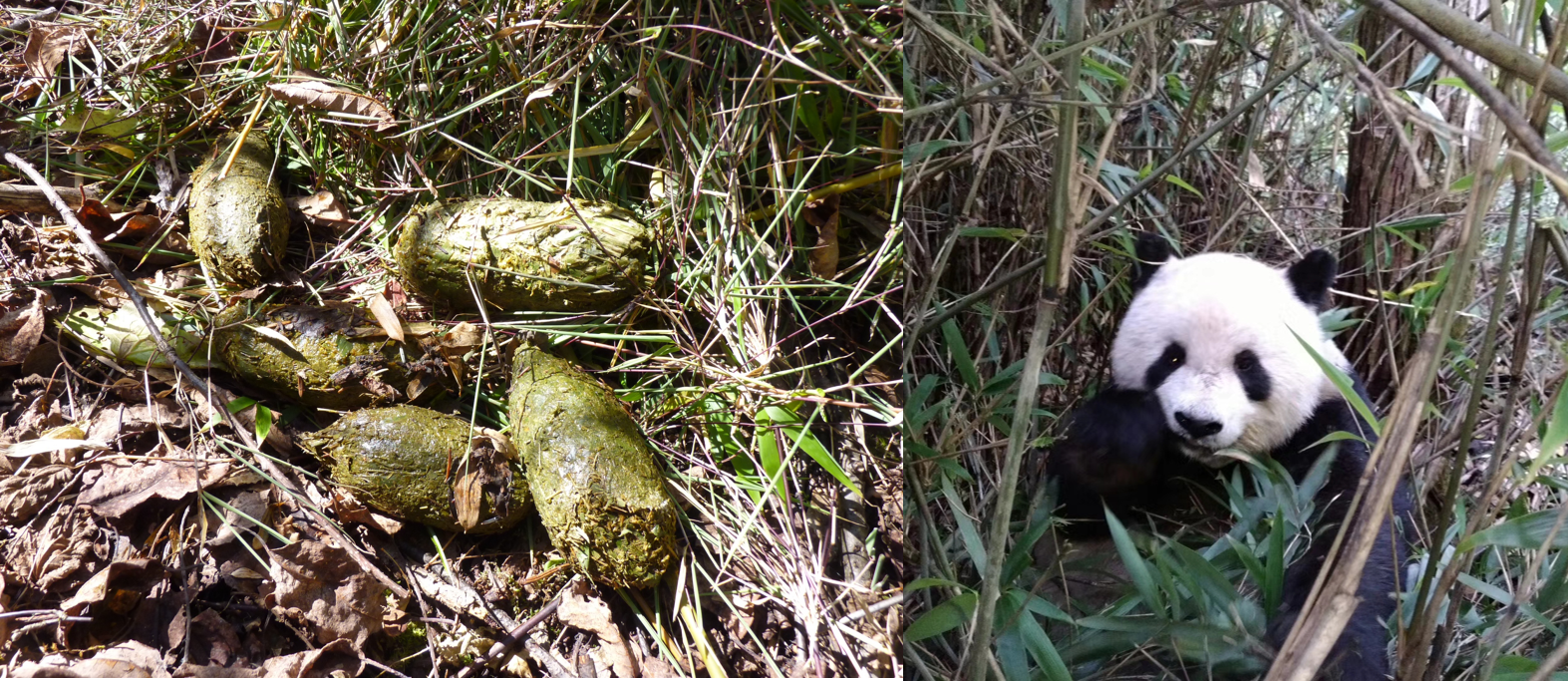On a mountain in China a giant panda spends hours sitting eating bamboo but there is no time for a scientist to sit when you are trying to understand panda diet

You don’t need to find a giant panda to study their diet but that doesn’t make finding samples easy. Left: Panda scats; Right: Giant panda feeding on bamboo Photographer: L Neaves and Wang Yizhi
Recently, we spent over 3 weeks in the mountains of Sichuan, China searching for giant panda poo, also known as scats, so we can study which plants and animals giant pandas feed on (Yes, they do occasionally eat other animals!). We hope to learn more about how the unique relationship between panda and bamboo evolved and how best to manage and restore giant panda habitat.
Giant panda are well-known for their highly specialised diet of bamboo and for being very picky about which bamboos they eat. As many as 60 different bamboos appear to occur in their habitat and diet, but it is actually very difficult to tell these bamboos apart. When you add this with the difficulties of observing pandas in the wild, we may not really know that much about the details of their diet. Plus, we know that occasionally giant panda eat other plants and even animals but we don’t really know how often this happens or why (find out more about this project here).
The mountains of Sichuan, where most of the wild giant pandas live are spectacular, to say the least, and home to a wide diversity of plants and animals. The steep slopes, and often dense bamboo forests giant panda live in makes them difficult to study. But we don’t actually need to see pandas feeding to learn about what they have been eating, we really only need to look at their scats. By sequencing in the DNA in their scats we can identify the panda the scat came from and what it has been eating (find out more about DNA sequencing scats here).
The steep slopes, and often dense bamboo forests giant panda live in makes them difficult to study. But we don’t actually need to see pandas feeding to learn about what they have been eating, we really only need to look at their scats. By sequencing in the DNA in their scats we can identify the panda the scat came from and what it has been eating (find out more about DNA sequencing scats here).
First, you have to find some giant panda scats to study and that is easier said than done.
We spent over 3 weeks climbing and traversing the Sichuan Mountains in search of panda scats, reaching altitudes of 3200 m. Scats may be easier to find than a panda but it is still very difficult in the dense bamboo forests on the steep slopes. We negotiated numerous steep slippery near vertical slopes, river crossings and moss-covered bridges (usually 2-3 logs tied together) and of course ploughed through a seemingly endless and almost impenetrable forest of bamboo. At times the bamboo was a welcome change to climbing up the wet, slippery river beds because at least it gives you something to help you climb the steep slopes.
After a week we had seen evidence of giant pandas – paw prints in the mud, chewed leaves and stems of bamboos but still we had not been able to find any scats to collect. By this time we had also seen some of the wide diversity of species the conservation of the giant panda has helped protect, including takin (a type of goat the size of a cow), golden pheasant, Tibetan macaques (which almost attacked us) and the nests, prints and claw marks of black bears. We even found the scat of a leopard cat but no panda scats.

Morphological diversity of bamboos in two key characters used for identification, including some variation within species. From left to right: Fargesia nitida, F. denudata, f. rufa, F. rufa, F. denudata
Our time was never wasted though, because we were also recording and collecting the many bamboos we came across. This will help us understand panda diet in more detail because we can understand which species are in an area, and use DNA from these samples as a reference to compare to the ‘poo DNA’ to identify plants and animals in the diet. However, these samples will also let us investigate how bamboos on different mountains and in different mountain ranges are related. This is important for understanding the evolution of these species along with giant panda, and how they might respond to climate change in the future.
Then, after 10 days in the field on a mountain side at 3100 m above sea level, we found it – the scats from a giant panda only a few days old. By the end of that day we had found 6 samples. We work closely with researchers and reserve staff in China and with their help we have now been able to locate many more samples. Now there will be many months of hard work in the lab to examine the DNA sequence from both the bamboos we collected and then the panda scats to work out exactly which plants and animals the giant panda feed on.
Acknowledgement – We thank Tangjiahe, Laghegou and Wanglang Nature Reserves and the China Conservation & Research Center for the Giant Panda for allowing permission and access and for the invaluable help of their staff in the field.
